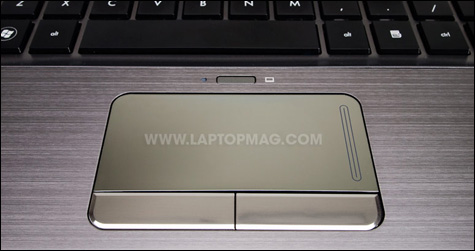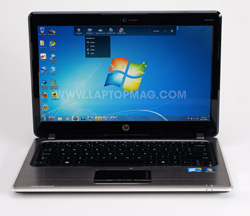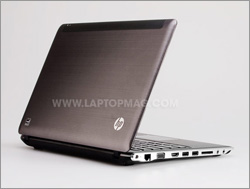Laptop Mag Verdict
This sleek aluminum-clad notebook offers good performance and over 9 hours of battery life, but its touchpad slows you down.
Pros
- +
Very long battery life
- +
Stylish, slim brushed aluminum design
- +
Comfortable keyboard
- +
Good low-light webcam
- +
Fairly loud speakers
Cons
- -
Poor touchpad
- -
Narrow vertical viewing angles
- -
Bottom left side runs warm
Why you can trust Laptop Mag
Ultrathin and decked out in brushed aluminum, the HP Pavilion dm3t is one of the best looking notebooks of the year. In fact, it looks more expensive than its price tag would suggest (starting at $649; $839 as configured). And thanks to an Ultra-Low Voltage Intel processor, this Windows 7 system lasts all day on a charge while offering good performance compared to the competition. However, the sluggish touchpad on the dm3t makes this laptop more difficult to use than it should be.
Design
You don't have to splurge for a $1,599 Envy 13 to get a notebook made with premium materials in HP's lineup. Like its higher priced cousin, the Pavilion dm3t uses a combination of aluminum (on the deck and lid), while the bottom casing is made of aluminum alloy. We especially like the Moderno Argento gray finish and how it contrasts with the glossy black display bezel. This brushed metal looks a bit more modern than the ASUS UL30A, which has a lighter-colored aluminum lid but a plastic deck (albeit with a cool intersecting pattern).
The 4.2-pound dm3t is heavier than both the UL30 (4.0 pounds) and the Envy 13 (3.8 pounds), but because it omits a DVD drive, it measures just 1.0 inch thin; we had no problem slipping this laptop in a backpack.
HP took a minimalist approach to the rest of the design, and it mostly pays off. Like the Inspiron 14z, we like that dm3t skips dedicated multimedia keys and instead uses the top row on the keyboard for controlling playback and quickly adjusting things like brightness and volume--no function commands required. Other welcome touches include a red LED above the mute button (to let you know when it's activated) and a touchpad lock button that changes from white to red when engaged. We just wish that the power button was up top for easy access; instead, it's a switch on the right side.
Keyboard and Touchpad
We have good news and bad news. The dm3t has one of the better keyboards in its class, with a well-spaced and thoughtfully designed chicklet-style layout. We were typing quickly in no time, and the keys provided just enough bounce. Our only quibbles here are that the up and down arrow keys are shrunken (most likely to accommodate the large right Shift key), and that the keys aren't backlit.
Where the ergonomic experience takes a turn for the worse is with the touchpad. Not only is this silver mirrored surface too glossy (it picked up fingerprint smudges fast), but the cursor kept getting stuck, and we had to make multiple swipes to move across the desktop. It actually felt like we were fighting the touchpad. Increasing the pointing speed improved things a bit, but the cursor was still jumpy. Our advice: try before you buy. The silver touchpad buttons are plenty large, if a bit narrow, and offered good tactile feedback.

Click to enlarge
Display and Sound
The 13.3-inch glossy display on the dm3t packs the same amount of pixels as most other ultrathin notebooks (1366 x 768), and the screen was fairly bright and crisp when surfing the Web, viewing photos, watching House on Hulu, and writing this review in WordPad. Side-to-side viewing angles are acceptably generous, but we had to tilt the display back 15 degrees or so with the notebook in our lap to see text and images clearly.
HP mounted the Altec Lansing speakers (with SRS Premium Sound technology) right underneath the front lip of the notebook. When we streamed "Welcome to Paradise" from Green Day using Slacker, the audio was loud enough to fill a small office. However, we wouldn't go past three-quarter volume, since the sound distorts quickly as you approach the max. Dialog in an episode of Heroes and Community was clear and crisp.
Ports and Webcam
The left side of the dm3t (from back to front) has the power jack, Ethernet, VGA, HDMI, two USB, a 5-in-1 memory card reader, and headphone and microphone jacks. A Kensington lock slot, two additional USB ports, and both a Wi-Fi on/off button and the power switch line the right side of the system.

Click to enlarge

Click to enlarge
When we used the integrated HP webcam for a Skype call, our colleague noted that the picture was relatively clear, and that our face was still easily visible when we moved into a dark room. The dm3t's low-light performance was particularly strong.
Performance
Powered by a 1.3-GHz Intel Core 2 Duo U7300 processor and 2GB of RAM, our configuration of the dm3t notched a PCMark Vantage score of 2,874. That's below the thin-and-light notebook average of 3,101, but about 400 points above the similarly equipped $799 ASUS UL30A. The dm3t also beat out the Toshiba Satellite T135 (2,701), although that system costs only $709.
Anecdotally, the dm3t was relatively snappy when switching between multiple open windows, and a high-res version of a Heroes episode streamed from Hulu had plenty of detail. The only time the system would hang is when we used HP's MediaSmart software.
For a Windows 7 notebook, we had hoped the dm3t would boot faster. At 1 minute and 10 seconds, this laptop takes about 10 seconds longer than average. On the plus side, this system's 7,200-rpm hard drive completed the LAPTOP Transfer Test, in which we copy 4.97GB of mixed media from one folder to another on a notebook, in a relatively brisk 3:47. That translates to a data rate of 22.4 MBps, better than the 20.75 MBps average.
Graphics
Given that this configuration of the dm3t has Intel's integrated graphics (GMA 4500MHD), we didn't expect blistering performance. The system's 3DMark06 score was predictably low at 703, or about half the thin-and-light category average. You can also forget about playing demanding games like Far Cry 2; the dm3t mustered only 4 frames per second at 1024 x 768.
On the other hand, doing a flyover to our Manhattan office in Google Earth was pretty smooth, and it took a respectable 15 seconds for most the details to fill in on the satellite view. We also tested this laptop's graphics and video muscle by outputting a full 1080p movie trailer (Cloudy with a Chance of Meatballs) to a 32-inch Samsung TV using the dm3t's HDMI port. Playback was highly detailed, and we didn't notice any hiccups during fast action sequences.
Heat
Although the dm3t runs relatively quiet, we did notice that the bottom left side of the notebook got very warm. After watching a few minutes of Hulu we measured a temperature of 102 degrees Fahrenheit. (Anything above 100 degrees feels uncomfortable on your lap.) All other areas of the system, however, remained mostly cool to the touch. Between the G and H keys measured 85 degrees, and the touchpad measured 87 degrees. The bottom of the notebook towards the back also stayed between 80 and 85 degrees.
Battery Life and Wi-Fi
Because the ULV CPU inside the dm3t sips power, the six-cell battery lasted an impressive 9 hours and 7 minutes on the LAPTOP Battery Test (continuous Web surfing over Wi-Fi). This endurance is significantly better than the Toshiba T135's 7:23, but the ASUS UL30A is still the champ in this category with a run time of 9:55. Nevertheless, you'll be able to use dm3t for most--if not all--of the day before needing to hunt for an outlet.
The dm3t's 802.11n connection delivered good throughput, especially further away from our router. This system notched data rates of 19.4 Mbps and 18.2 Mbps, respectively, from 15 and 50 feet. Our Heroes Hulu stream held nice and steady from the latter distance.
Green Testing

Click to enlargeThe Pavilion dm3 is rated silver by EPEAT, and it's also Energy Star qualified. In our tests, we found the system to be quite efficient as well. The machine used a total of 7117.5 watts to fully charge, or an average of 36.5 watts. When you divide the total number of watts by the dm3t's battery life you get a LAPTOP Battery Efficiency Rating of 13.0. This is even better than the ASUS UL30A (14.0) and the Toshiba Satellite T135 (16.9).
Software and Support
The dm3t comes with HP's MediaSmart software, which is slick but slow. It lets you easily access music, pictures, videos, and more. We especially like the Pandora player in the music app. However, we noticed that the notebook had trouble keeping up with the program, as Windows 7's spinning circle kept rearing its ugly head. Another somewhat unique app is HP PC Dock, which lets you drag programs to it for shortcuts. Since the Windows 7 taskbar already performs this function, we think the dock is redundant in this regard.
Where the dock does add some value is PC Dashboard, which lets you see your security status and important update alerts at a glance. You can also get help via HP Support Assistant. We'd shy away from PC Discovery, though; it's mostly a thinly veiled pitch for third-party software.
HP backs the dm3t with one-year limited hardware warranty and 24/7 toll-free tech support. You can see how HP fared in our Tech Support Showdown by clicking here.
Configuration Options

Click to enlargeThe HP dm3t is highly configurable online. The $649 base model includes a 1.3-GHz Intel Pentium SU4100 processor, 2GB of RAM, and a 250GB hard drive. If you prefer an AMD processor, opt for the dm3z model, which starts at$549.
You can step up to a Core 2 Duo SU7300 processor with the same clock speed but more cache (3MB vs. 2MB) for $50 more. If you want better graphics muscle for games and video editing, you can pair the above processor with Nvidia's GeForce G 105M card ($100 upsell), or splurge for a 2.26-GHz Intel Core 2 Duo SP9300 with the same Nvidia graphics.
On the memory front, you can upgrade to 3GB for free or 4GB for $40. 6GB ($240) and 8GB ($440) options are also available, but for most that's just overkill. Hard drive upgrade options include a 320GB or 500GB drive running at 5,400 rpm ($40, $90) or 7,200 rpm ($60, $100). All of these drives have ProtectSmart Hard Drive Protection to shield your data in case of a fall.
Want to stay connected everywhere? The built-in HP Mobile Broadband card costs a steep $125, but it works with AT&T, Sprint, and Verizon Wireless.
Verdict
There's a lot to like about the HP Pavilion dm3t. It's sleek, lasts all day on a charge, and performs well. Plus, you have the choice of adding discrete graphics. Unfortunately, the imprecise touchpad on this machine slowed us down, and literally made us less productive while using it. Overall, we recommend the ASUS UL30A because of its better ergonomics. But if you can live with its few flaws, there are enough things going for the dm3t to make it a worthwhile purchase.
HP Pavilion dm3t Specs
| Bluetooth | Bluetooth 2.1 |
| Brand | HP |
| CPU | 1.3-GHz Core 2 Duo SU7300 |
| Card Slots | 5-1 card reader |
| Company Website | www.hp.com |
| Display Size | 13.3 |
| Graphics Card | Intel GMA 4500MHD |
| Hard Drive Size | 500GB |
| Hard Drive Speed | 5,400rpm |
| Hard Drive Type | SATA Hard Drive |
| Native Resolution | 1366x768 |
| Operating System | MS Windows 7 Home Premium (64-bit) |
| Ports (excluding USB) | Headphone, HDMI, Ethernet, Audio-in, VGA |
| RAM | 2GB |
| RAM Upgradable to | 8GB |
| Size | 12.8 x 9.1 x 1.0 inches |
| USB Ports | 4 |
| Video Memory | Shared |
| Weight | 4.2 pounds |
| Wi-Fi | 802.11n |

